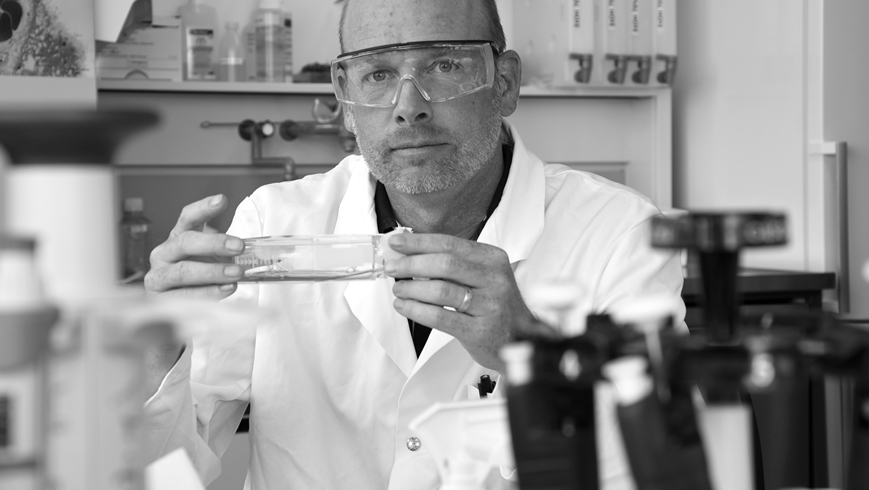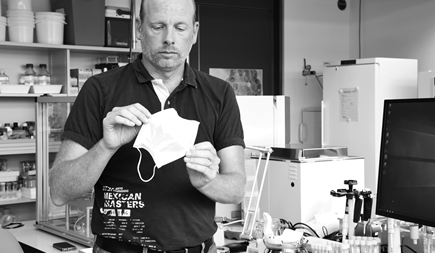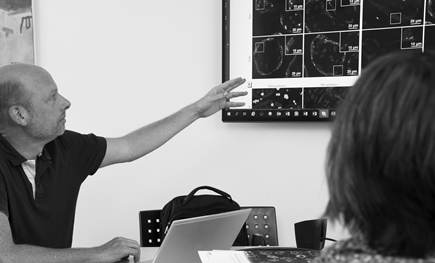Research in times of COVID-19
"Crucial results for corona vaccination strategy"
Efforts are being made worldwide to combat the new coronavirus SARS-CoV-2. Vaccines and protective masks are of prime importance. Empa researcher Peter Wick, Head of the Particles-Biology Interactions Laboratory in St. Gallen, talks to Empa Quarterly about recent antibody studies, which are crucial for the development of a COVID-19 vaccine, and the next generation of textile protective materials that inactivate or even kill corona viruses.

Currently, the search for a corona vaccine is at the center of attention. An antibody study, in which your team was involved, has now provided evidence of immunity to the virus. What lessons are to be learned from your results?
Peter Wick: In the study with 160 people who had a confirmed but rather mild COVID-19 infection, we analyzed the antibody levels in the patients' serum over a period of twelve weeks in collaboration with the Center for Laboratory Medicine (ZLM) and the Cantonal Department of Health in St. Gallen. What worried us was that the antibody response to the virus already started to decline just five weeks after the infection. So if patients were receptive to the corona virus just two months after an infection, as our data suggest, we shouldn't bet on the often-cited "herd immunity". Because in this case there would be no general protection of the population based on people who have been through an infection and are thus immune.

What does this mean for a potential COVID 19 vaccination strategy?
These results are crucial for the COVID vaccination strategy. After all, a vaccine is designed to elicit an immune response in the body by simulating an infection and thereby generating long-lasting protection. Based on our data, it is conceivable that a COVID vaccination only provides relatively short-term protection. However, this is of course also dependent on the type of vaccine and the interval between booster shots.
Do all infected persons react in the same way with a relatively rapidly decreasing immune response?
No, this does not seem to be the case. We have found that the trend towards a decreasing immune response is more pronounced in men than in women. Although the cohort of 160 patients over a period of 12 weeks offers a good and lengthy insight into the course of infection when compared to other studies on COVID-19, for a statistically significant characterization of subgroups, i.e. age, gender, etc., the cohort would have to be considerably larger, however.
So, do you plan a follow-up study?
The current study has shown a first trend. Now we want to take a closer look at the immune reactions together with our colleagues at ZLM. With regard to personalized medicine, the segregation of well-defined subpopulations of infected individuals is an important aspect. Thus vaccination strategies could possibly differ for distinct patients or patient groups, for example depending on age, gender or risk factors. In a follow-up of the antibody study, we now want to enlarge the cohort and collect more data over a longer period of time. In addition, another aspect of the immune response will also be monitored – the cellular immune response. There are already hints that these specialized immune cells and their chemical messengers also react differently to coronavirus in men and women.

Empa is a driving force within the ReMask consortium. What progress can be expected in mask development?
We are working – together with our industrial partners, clinicians and the ReMask network – on a new generation of protective materials. These include, for instance, masks with an antiviral coating. A whole range of options are possible here that inactivate or even destroy viruses, such as nanocoatings or surface functionalizations. But other textiles can also be equipped with protective capacities. Antiviral curtains, clothing for health personnel, or seat covers for public transport are also an issue. We are in constant exchange with our industry and research partners to identify the needs for novel efficient solutions. In this way, Swiss industry can be at the forefront of product development.
Empa has developed recommendations for textile community masks. Are such washable textile masks also ecologically beneficial?
We are currently planning to carry out comprehensive comparative analyses of textile and disposable masks and to draw up life cycle assessments. Because there are important questions which go beyond the actual effectiveness of the masks. These include health and safety aspects. Are fibers rubbed off in the washing machine, and do fiber fragments end up in the waste water? Do we inhale nanoparticles that come off coated masks? These are the questions we are investigating together with Empa's "Technology and Society" lab. We also benefit from our well-established lung model ALI, short for "Air Liquid Interface Exposure System". Thanks to ALI we can, for example, investigate how lung cells react to airborne particles, in the same way as it occurs during respiration in the human body.
Can the current pandemic also bring positive aspects for future research?
Even at the beginning of the corona pandemic, we were able to rely on our excellent research infrastructure and our huge network in order to transfer new ideas into practical clinical applications as quickly as possible, just as we do every day as a "cradle of innovation" in Switzerland. Overall, however, it must be said that such a situation is an enormous challenge for society – but also an opportunity for the research scene. Switzerland's research community has cooperated extremely intensively during the crisis and has responded swiftly and flexibly to the needs of society. For our research, this has led to an increase in digital solutions and strengthened our efforts to use big data analyses to complement experimental work and the work of our clinical partners.
In addition, we are currently establishing a method that will also be suitable for future applications. For example, manufacturers of protective materials must have their products tested for their protective effect against viruses during the development phase. Until now, this has been a complex procedure that could only be carried out in highly specialized laboratories. We want to accelerate these development steps by designing alternative methods, such as inactivated, harmless viruses that are equipped with fluorescent dyes and that light up once the pathogens have been neutralized by a functionalized surface. Once this method is established, product developers will be able to examine their materials at an early stage without having to call in a high-security lab. Efficacy tests with infectious viruses will then only be necessary for the approval of the final product.
Dr. Peter Wick
Particles-Biology Interactions
Phone +41 58 765 7684
Peter.Wick@empa.ch
Dr. Matthias Rösslein
Particles-Biology Interactions
Phone +41 58 765 7784
Matthias.Roesslein@empa.ch
Claudia Som
Technology and Society
Phone +41 58 765 7843
Claudia.Som@empa.ch
Joining forces against the mask shortage (April 23, 2020): www.empa.ch/web/s604/remask
Hello Mask: First transparent surgical mask goes into production (June 9, 2020): www.empa.ch/web/s604/hello-mask-hmcare
How to assure high quality masks (May 14, 2020): www.empa.ch/web/s604/coronamasken
A new biosensor for the COVID-19 virus (April 21, 2020): www.empa.ch/web/s604/coronatest
-
Share





